On last year’s visit to the Puy-de-Dôme, one of our most beloved and photographed regions in France, PJ and I decided to reshoot several churches that we had visited some years ago. One of those was the stunning Église Saint-Julien in Chauriat, a church we had featured in a prior post, De Profundis. Chauriat is above 25 kilometers east of Clermont-Ferrand and among a group of superb Romanesque churches, including those in Cournon-d’Auvergne, Billom, and Glaine-Montaigut.
We arrived early in the afternoon on a beautiful spring day to find the church empty for the entire time that we visited. It was a perfect time to photograph. The Église Saint-Julien was built in the 12th century as a convent church and was in the standard Auvergnat form of a cruciform church with an octagonal tower over the crossing, and an ambulatory with radiating chapels. This Romanesque chevet was replaced by a Gothic structure at a later date. The exterior decoration features the black volcanic stone of the region in mosaic patterns but it is likely that these were the product of the later restoration program of the church. The superb clocher is also not original but was rebuilt at a later date in the Romanesque style.
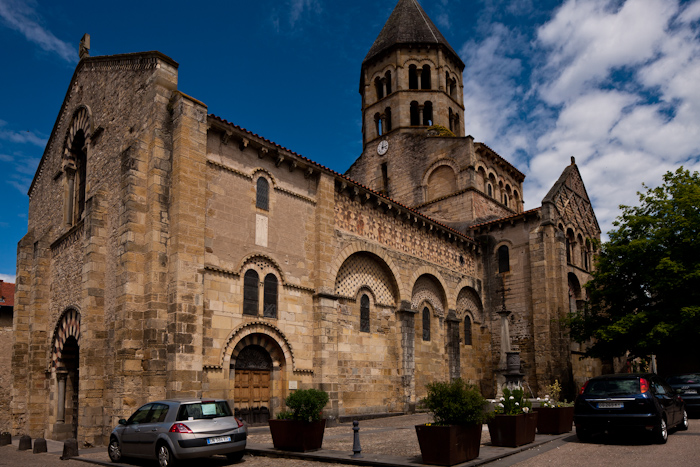
The nave features four bays with round arcade arches and is topped with an ogive banded barrel vault. The interior painting is familiar to us as a 19th century restoration touch, most likely based on remnants of the original polychrome decoration.
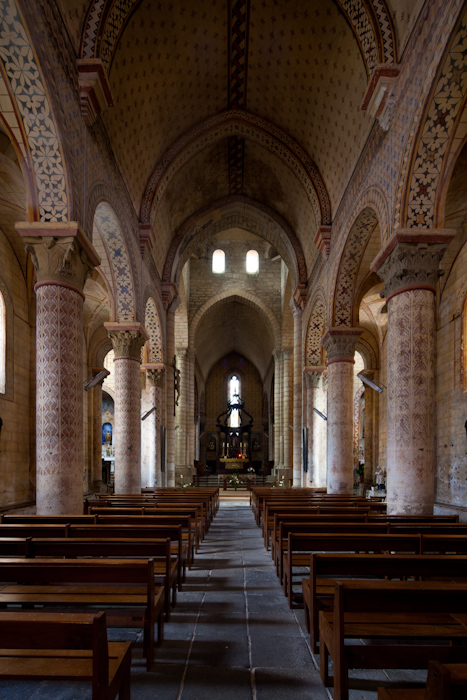
In the nave elevation we can see the round arcade arches contrasting with the ogive transept arches and the ogive vault. Also, there is no clerestory level. The vault springs directly from the nave arcade. The interior illumination comes from the windows in the side aisles.

The side aisles are groin-vaulted which allows for the large windows to the exterior. Notice the broad decorated bands separating the groin vaults. The construction using stones of different colors is a wonderful adornment to complement the painted interior.
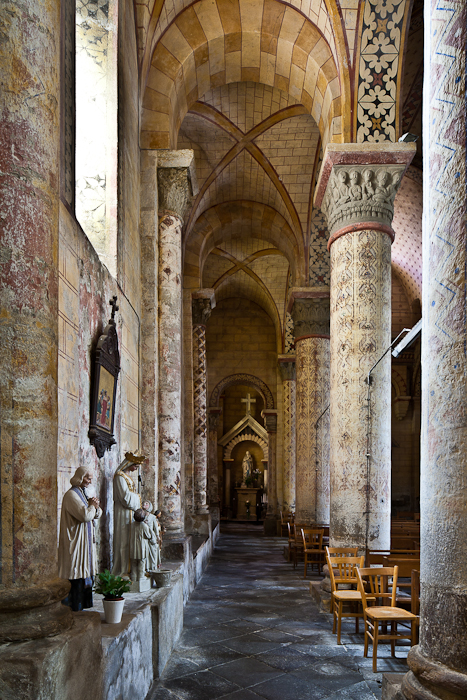
PJ’s photo from the side aisle to the crossing shows the wonderful organization of the different arches that create the support structure for the interior and exterior walls. This is truly a finely structured church and does not require decoration for us to appreciate its beauty.

There is one significant difference between Saint-Julien de Chauriat and her sister churches in the region – the Romanesque chevet has been replaced with a rather plain Gothic version. There is an ambulatory but there are no radiating chapels.

There are fine capitals throughout the church and some are at a much lower level than the others, probably because of restoration in the 19th century. This photograph features the sirene capital on the north arcade.
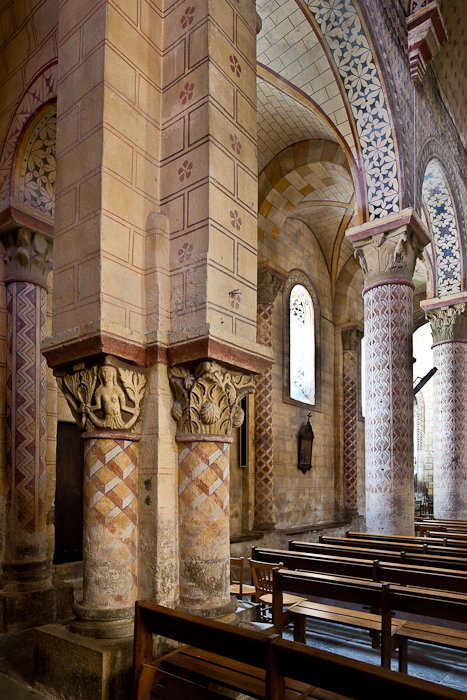
One of my favorite capitals in the Église Saint-Julien is the Last Supper. Notice how the disciples are holding hands and that the action continues around the other surfaces of the capital.
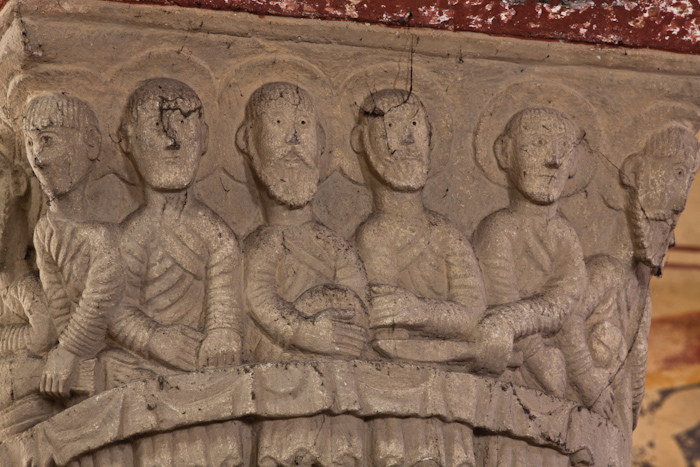
On the opposite face of the Last Supper capital is a rendition of the story of “Christ washing the feet of the disciples”, reflecting the story in John 13.
For I have given you an example, that ye should do as I have done to you.
Verily, verily, I say unto you, The servant is not greater than his lord;
neither he that is sent greater than he that sent him. John 13:15-16 King James Version
We can see on either side of this scene the Last Supper tableau. Altogether there are seventeen figures crammed into this scene.
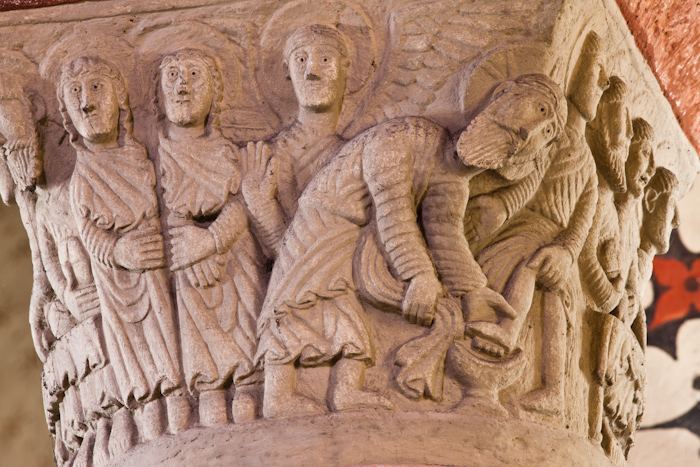
It is not surprising that an Auvergnat church would have a fine vierge romane, and Chauriat has one of the most magnificent. Our first visit to the church in 2007 was specifically to photograph the 12th century Notre Dame de Chauriat, and while we returned to spend more time photographing the church, I couldn’t help another session with the vierge. Everything from her dignified bearing, fine workmanship, and beautiful polychrome remind us that she has been an object of veneration for almost a thousand years.
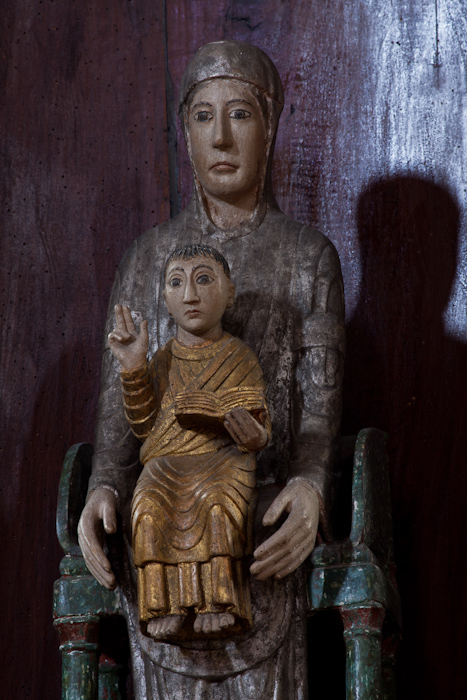
A last note on this superb church – access is granted by getting a key from the Mairie across the square. The key itself is quite a feature, a large iron key fitting for such an old monument. For us it almost matches the grand-daddy of them all at Peyrusse in the Haute-Loire.
Location: 45.751037° 3.279917°

Although the decoration was added during a renovation, it was interesting to see how the colors had been worn away at the base of the columns by years of touching and rubbing. Excellent result from your second visit.
Vann, one of our favorite churches there. The restoration is from the mid-19th century – this was one of the earliest churches put on the patrimony list, for good reason, obviously. Thanks for your commentary, as always.
Cool capitals and nice photos. Thanks for letting us know how to get the key:)
Yuri, thanks for this. When you come across a locked church in France, there is a pretty good chance that the key will be found in the mairie.
I’ve only been following your blog for the past few months. I was very happy to discover it because I have a great interest in old churches, especially Romanesque churches. The church you’ve blogged about today is one I haven’t seen yet, but it will be saved and visited at the first opportunity. I really enjoy your work. Thank you.
Libbie
Thank you, Libby. If you go to the list of “Featured Churches”, it links to the map that shows those churches about which we have written.
Do you see Byzantine influence?
Definitely in the painting, but that was the 19th century style that seemed to predominate in the Auvergne restorations.
I’m fascinated by the capital of Christ washing the apostle’s feet. At least two of the figures appear to be be women. You say there is a total of 17 figures. If Christ is one of the 17, there would be 16 other figures. There were 13 apostles (the original 12 and original 12 plus the 13th apostle added following Judas’s death), which would leave three other figures to account for among the 17. Could the other three be the three Mary’s?
Gordon, some of the figures are repeated. For example, it is thought that the three figures standing to the left of Christ washing the feet are apostles who would also be seen sitting at the table. I think we have Christ and the 12 apostles at the table (total 13) and Christ and the 3 apostles (washing to foot of another at the table) making a total of 17. There is a displacement of time and space here, I believe:)